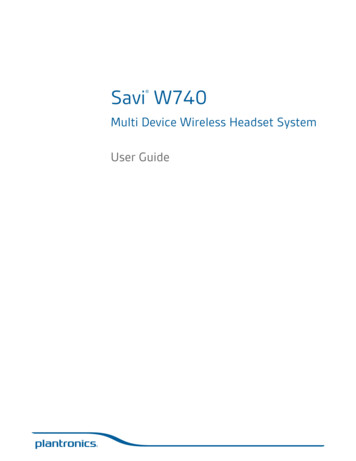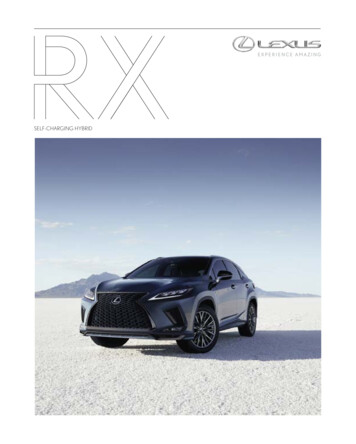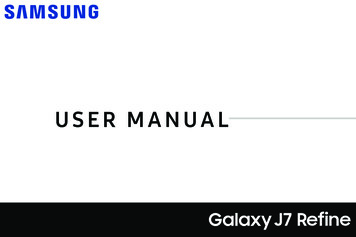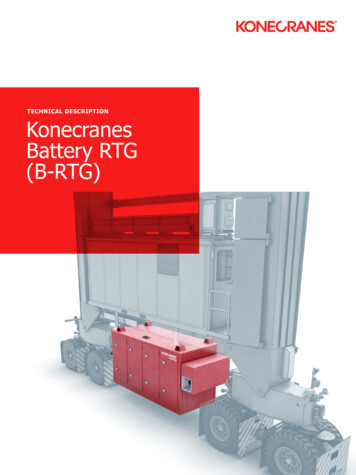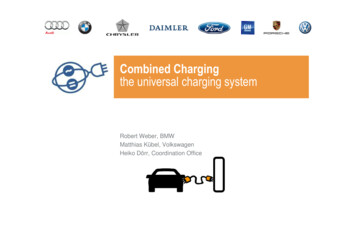
Transcription
Combined Chargingthe universal charging systemRobert Weber, BMWMatthias Kübel, VolkswagenHeiko Dörr, Coordination Office
Current Status Charging SystemsThe main regions for e-Mobility have developed individual charging systems.One global solution needed.1st Step: start of e-Mobility with AC and DC2nd Step: after migrationRegional, mutually incompatible connectorsCombined Charging System forglobal AC and DC chargingGeschäftsstelle Ladeschnittstellec/o Carmeq GmbHCombined Charging Survey, V1.32
Costumer Expectations drive Charging CapabilitiesAll DC fast-charging should be designed to meet customer needs andwants.Long rangetravels ICE vehicles have a wide operating range Operating range of current Battery EVs iscomparably limited before refueling Consumers expect convenient vehiclefueling/chargingPower accessat multifamilyhomes Many consumers don’t have access at home to aconvenient place to charge a plug-in EV. Consumers still need a place to charge at/nearhomeEmergencycharging Battery driving range is sufficient for the vastmajority of everyday trips Uncertainty of range limits to be overcome by fastcharging spotsGeschäftsstelle Ladeschnittstellec/o Carmeq GmbHCombined Charging Survey, V1.33
Design Requirements for the Combined Charging SystemAC national standards remain the same.Two additional Pins allow DC charging in the same vehicle inlet while acceptingthe legacy AC connector.up to8hType 2Type 1CoreCoreHighPowerHighPowerDCHow to speed up from up to 8 h charging to 20 min?DC20 minGeschäftsstelle Ladeschnittstellec/o Carmeq GmbHCombined Charging Survey, V1.34
How the Combined Charging System RespondsAC national standards remain the same.Two additional Pins allow DC charging in the same vehicle inlet while acceptingthe legacy AC connector.up to8hType 2Type 1CoreCoreHighPowerHighPowerDCDC20 minGeschäftsstelle Ladeschnittstellec/o Carmeq GmbHCombined Charging Survey, V1.35
Design DC Combo 2 InletThe Combo 2 inlet provides comprehensive functionalityat a high level of safety.Safety features1Function1Diagnosable lock1-phase AC charging with Type 222Integration into smart gridProximity and control pilot33-phase AC charging with Type 24High power DC charging viadedicated pinsGeschäftsstelle Ladeschnittstellec/o Carmeq GmbHCombined Charging Survey, V1.36
Charging Connectors for the Combined Charging SystemThe Combo inlet shall serve as a universal plug for all relevant phGeschäftsstelle Ladeschnittstellec/o Carmeq GmbHCombined Charging Survey, V1.37
Combined Charging Connector ConceptThe Combined Charging System integrates the existing AC connectors,allowing for one standard global vehicle interface for AC and DC charging.ConnectorUSAEuropeApplication range5 kW50 kW100 kWkWAC 3,7AC 10AC 22DC 86Geschäftsstelle Ladeschnittstellec/o Carmeq GmbHCombined Charging Survey, V1.38
Comparison Combo 2 and alternative ApproachesIntegration of AC and DC into a single inlet provides high freedom for vehicledesign and in addition a reduction of size.CHAdeMO Type 270102x325422 xCombo 2Scale 2:374Scale 2:3Geschäftsstelle Ladeschnittstellec/o Carmeq GmbHCombined Charging Survey, V1.39
Impact on Vehicle Costs – Combined System vs Separate SystemsSeparation of AC and DC charging systems has significant extra costs.Total cost for customer is reduced by application of Combined Charging System.Combined Charging System Integrated electric architecture which implements allrelevant AC and DC charging scenarios Integration of AC and DC in one single inletAC plus DC ChargingCHAdeMO with separate charging systems No integrated architecture for both AC and DC charging Separate AC and DC connectors with two inlets in thevehicleDC ChargingAC ChargingConsequences of a second separated charging system: Module costs much higher than 50 according to expertevaluation* Loss of installation space and freedom of designthrough additional inlet*depends on implementationGeschäftsstelle Ladeschnittstellec/o Carmeq GmbHCombined Charging Survey, V1.310
Efficiency of Combined ChargingIntegration of AC and DC in the vehicle architecture may be applied to chargingstations accordingly.ConnectorType 1Electric VehicleType 2AC 1phCPLPPNPENPPPEL1Type 1InletCPCPPPControl Unitwith PWMand PLCNAC 3phCPNPPPEL3L1Type 2InletL1/ LL2L2AC-ChargingUnit(1- or 3- phase)L3Combo 1InletDC highCPPEPPPEPPPECPHV SupplySystemwithBatteryDC - - Combo 2InletDC DC-RelayGeschäftsstelle Ladeschnittstellec/o Carmeq GmbHDesign of charging stations, V3.011
Combined Charging SystemLow Complexity and Cost Optimized:Cost efficient re-use of multiple parts, resulting in win – win situation.Electric VehicleLockPECommunicationDCBenefits ChargeControlBatterySystemOne inletNo extra design requiredDC re-uses the complete AC communication and adds only DC specific dataExtensive use of same partsGeschäftsstelle Ladeschnittstellec/o Carmeq GmbHCombined Charging Survey, V1.312
Design Combo InletEasy Handling and Widely Spread User Acceptance: Single car design conceptthat enables fuel tank as well as combined AC/ DC charging inlet.The combo inlet fits behind typical fuel doorsNo need for variantsGeschäftsstelle Ladeschnittstellec/o Carmeq GmbHCombined Charging Survey, V1.313
Video DemonstrationGeschäftsstelle Ladeschnittstellec/o Carmeq GmbHCombined Charging, Key Challenges of e-Mobility V0.414
Simplified ArchitectureTo focus on the relevant components for high power DC chargingGeschäftsstelle Ladeschnittstellec/o Carmeq GmbHDesign of Charging System, V3.015
High Power DC ChargingPilot enters state B instantly (very fast hardware based communication).Vehicle immobilized.Geschäftsstelle Ladeschnittstellec/o Carmeq GmbHDesign of Charging System, V3.016
High Power DC ChargingClose lock. Establish PLC communication: Exchange operating limits andparameters of charging. In the end, pilot enters state C.Geschäftsstelle Ladeschnittstellec/o Carmeq GmbHDesign of Charging System, V3.017
High Power DC ChargingEVSE performs isolation monitor self test and then initial internal isolation check.EV performs initial internal isolation check.Geschäftsstelle Ladeschnittstellec/o Carmeq GmbHDesign of Charging System, V3.018
High Power DC ChargingEVSE enables high power DC output. EV requests voltage to synchronize withbattery level. Voltage plausibility check is performed. EV closes DC relays.Geschäftsstelle Ladeschnittstellec/o Carmeq GmbHDesign of Charging System, V3.019
High Power DC ChargingEVSE transfers energy per EV request.Continuous monitoring of lock, isolation, voltage and temperature.Geschäftsstelle Ladeschnittstellec/o Carmeq GmbHDesign of Charging System, V3.020
High Power DC ChargingPer EV request and pilot state B, EVSE regulates current close to zero and voltageclose to UBat (descending rate of 100 A/s).Geschäftsstelle Ladeschnittstellec/o Carmeq GmbHDesign of Charging System, V3.021
High Power DC ChargingEV and EVSE open relays. EVSE disables high power DC supply. Any monitoringwill be stopped. Lock is disabled. PLC communication is terminated.Geschäftsstelle Ladeschnittstellec/o Carmeq GmbHDesign of Charging System, V3.022
High Power DC ChargingMobilize vehicle.Geschäftsstelle Ladeschnittstellec/o Carmeq GmbHDesign of Charging System, V3.023
Charging Communication for DC ChargingThe charging communication between vehicle and charger is standardized inISO/IEC 15118 in close cooperation with SAE.DCACchargerbatterybatteryTasks Charging control requires a permanent communication between vehicle and chargepump. Current and voltage are adjusted continuously during chargingGoal SolutionOne communication system for all charging modes, world-wide:Requirements and functionalityTransmission technologySW protocols PLC-based communication ISO/IEC 15118 for all charging modes applyingIEEE 1901 HomePlug Greenphy, IPV6 and data securityGeschäftsstelle Ladeschnittstellec/o Carmeq GmbHCombined Charging Survey, V1.324
One Charging Communication for all Charging ModesThe Charging Communication shall realize intelligent charging with highcomfort by one implementation for both AC and DC charging.Support of controlled intelligent charging based on dynamic ratesForecast of network load through planned chargingSupport of fleet- and load-managementActive control of network loadControlledcharging AC and DCchargingcontrol Authentication with the same methods for AC and DC Charging DC Charging takes control over voltage and status information Same communication technology for AC and DC ChargingValue addedservicesSimplerealisation Certified payment and accounting system Future integration of vehicles in home networks or cloud services Integration of Electric Vehicles into Smart Grid Using existing connections One implementation for all charging modesGeschäftsstelle Ladeschnittstellec/o Carmeq GmbHCombined Charging Survey, V1.325
Charging Protocol defined by ISO/ IEC 15118DC Charging communication is standardized based on existing AC Chargingcommunication.DC Charging and AC Charging use the sameprotocol stack IPv6 based protocol Transport layer with dedicated securitymeasured Flexible XML-based messages AC as well as DC messagesLayer 7 –ApplicationLayer 6 –PresentationLayer 5 –SessionLayer 4 –TransportISO/IEC15118-3 focus on HomePlugGreenPhy as Layer 1 & Layer 2 solution HomePlug GreenPhy on Control Pilot Uses GreenPhy SLAAC for EV/EVSEAssociation Common Layer1 / Layer2 solution for AC andDC-ChargingLayer 3 –NetworkLayer 2 –Data LinkLayer 1 –PhysicalSmart ChargeProtocol(Application Layer Session Layer)SLAAC (StatelessAddressAutoconfiguration)Optional: DHCP(Dyn. HostConf. Protocol)EXI – Efficient XML interchangeV2GTP (Vehicle to GridTransfer Protocol)TLS (Transport LayerSecurity 1.0)TCP (TransmissionControl Protocol)Optional: HTTP (HypertextTransfer Protocol)UDP(User Datagram Protocol)IPv6 (Internet Protocol)IEEE1901HomePlugGreenPHYGeschäftsstelle Ladeschnittstellec/o Carmeq GmbHCombined Charging Survey, V1.326
Station for (Semi-)Public Infrastructure in EuropeMinimal infrastructure should be realized with a dedicated charging station.No specific equipment requirements for semi-public or private areas.Strategic Impact DC charging station withoutdiscrimination of AC charging asrequired by ACEA Backward compaible design ofpublic infrastructureGeschäftsstelle Ladeschnittstellec/o Carmeq GmbHDesign of charging stations, V3.027
Relevant International Standards for the Charging InterfaceThe charging system is comprised by a set of related standards.4Charging topology2Communication1ConnectorIEC 62196-1IEC 62196-3IEC 62196-23SAE J1772ISO/IEC 15118IEC 61850SAE J2847IEC 61851-1SAE J2931IEC 61851-24IEC 61851-21IEC 61851-23IEC 61851-22SafetyIEC 60529IEC 60364-7-722ISO 6469-3SAE J1766ISO 17409Geschäftsstelle Ladeschnittstellec/o Carmeq GmbHCombined Charging Survey, V1.328
StandardizationStandards for DC charging are ready and implementation baseline defined.ScopeBenefitsImplementationBaseline DC systems according to Combined Charging Systems will be created according toexisting standards: Connector:IEC 62196-3 CDV Topology:IEC 61851-23 CDV Communication: DIN Spec 70121 DIN SPEC 70121 refers to ISO / IEC 15118-1 DIS, -2 DIS and 15118-3 Series production of DC-Charging ongoing, Transparent requirements for allproducts on the market Common agreement by all stakeholders Standards aligned with SAE Series products available End of 2012 Vehicles on the market in 2013 with DC option will comply to implementationbaseline 2012 defined by IEC CDV 62196-3, IEC CDV 61851-23 and DIN SPEC70121Geschäftsstelle Ladeschnittstellec/o Carmeq GmbHCombined Charging Survey, V1.329
Summary of using DC Charging in Modellregion MunichFinal project presentation.ImpressionsFacts 17.10.2011 in Munich Ca. 100 guests stakeholder from industry andgovernment national press, customers LIVE CHARGINGDEMONSTRATION DC-Type 2 with PLC with 70A (up to 28kW) 85km e-range in 30min Press echo:Geschäftsstelle Ladeschnittstellec/o Carmeq GmbHCombined Charging Survey, V1.330
Electric Cars with Combo Inlet.Announced cars for 2013.GMChevy SparkBMWI3Volkswagene-up!Geschäftsstelle Ladeschnittstellec/o Carmeq GmbHCombined Charging Survey, V1.331
Strategic Assessment of existing Charging SystemsMain bodies have adopted the Combined Charging System as chargingtechnology. All members ofthe EuropeanAssociation ofAutomotiveManufacturersACEA support theCombined ChargingSystem for Europe: BMW, DAF, Daimler, Fiat, Ford ofEurope, General Motors Europe, HyundaiMotor Europe, Jaguar Land Rover, MAN,Porsche, PSA, Renault, Scania, ToyotaMotor Europe, Volkswagen, Volvo Cars,and AB Volvo. SAE has developed the CombinedCharging System in the U.S. The Combined Charging System is theUS solution for electric vehicle charging –from AC charging to ultra-fast DCcharging. Nearly all global automotive companiessupport the Combined Charging Systemincluding US manufactures ChryslerGroup LLC, Ford Motor Company, andGeneral Motors.Geschäftsstelle Ladeschnittstellec/o Carmeq GmbHCombined Charging Survey, V1.332
Combined Charging SystemCombined Charging: the universal charging system for electric vehicles hasbeen demonstrated with vehicles of German OEMs at the 15th internationalconference „Electronics in Vehicles“ at Baden-Baden on October 12-13, 2011.Geschäftsstelle Ladeschnittstellec/o Carmeq GmbHCombined Charging Survey, V1.333
Combined Charging System at EVS 26Geschäftsstelle Ladeschnittstellec/o Carmeq GmbHCombined Charging Survey, V1.334
Combined Charging System at eCarTecGeschäftsstelle Ladeschnittstellec/o Carmeq GmbHCombined Charging Survey, V1.335
Combined Charging Connector Concept Combined Charging Survey, V1.3 8 USA Europe Connector kW 5 kW 50 kW 100 kW Application range The Combined Charging System integrates the existing AC connectors, allowing for one standard global vehicle interface for AC and DC charging. AC 3,7 AC 22 DC 86 AC 10




